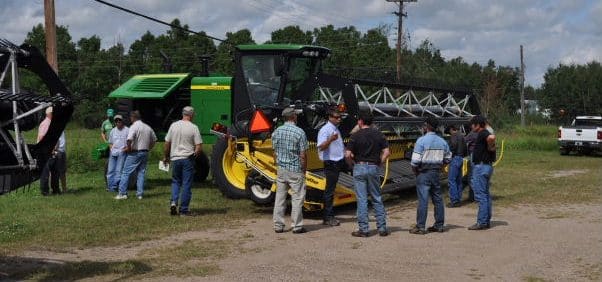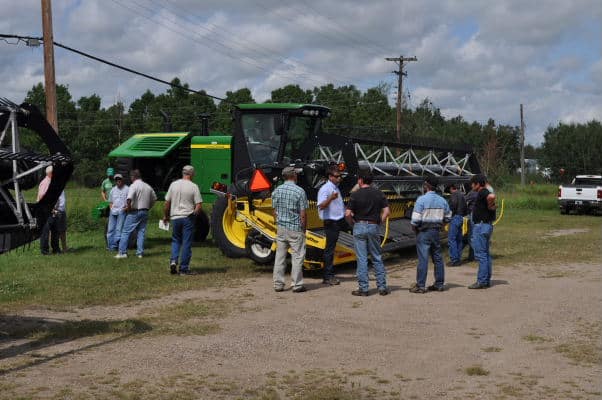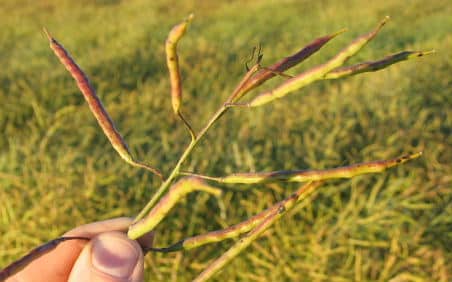10. Allows for time to scout for insect exit holes. Growers in southern Alberta and southwestern Saskatchewan where cabbage seedpod weevil counts are highest are encouraged to check pods for exit holes from weevil larvae. This will help determine if a spray application was 1) effective, 2) actually necessary or 3) warranted. When scouting if less than 25% of pods have exit holes, the spray could be considered a success. If less than 25% and the crop was not sprayed, it was probably the correct decision. If more than 25% and the crop was not sprayed, it probably should have been.
9. Allows for time to tune up the harvest equipment. Equipment can be tuned mechanically and operators can tweak harvest operations for the combine swather and swath roller.
8. More time to develop a safe harvest plan. Click here to start working on your safe harvest plan today.
7. Higher seed oil content. Research conducted by the Canola Council at Canola Production sites across western Canada showed increasing oil content with delayed swathing to 60% of seed colour change (SCC). Review the research trial data and find more information in Chapter 11 of the Canola Growers Manual.
6. Less risk of wind damage to the swath. Typically canola which is sitting in a swath will be somewhat anchored to the ground by its own stubble. Unfortunately, extreme winds last fall caused damage to swathed canola – remember that the longer a crop is sitting in swath, the greater the chance for wind damage to occur.
5. Might be sunscald or sunburn. Swath timing needs to be determined by seed colour change and not the colour change seen on pods. There are a number of things that need to be scouted and ruled out to ensure swathing is not happening too early. 1) Some varieties have pods that start to turn colour before the seed inside does. 2) Sunscald is starting to appear in some fields. Sunscald occurs when plants are ripening during periods of heat or other stresses and only appears on one side of the tissue exposed to the sun. And 3) some podded fields are also showing significant purpling like a sunburn which is a genetic response. Walk each field, scout thoroughly and crack pods to determine the level of seed colour change within.
4. Still only mid-August. In warm dry conditions, canola matures quickly and seed color change can increase by 10 percentage points in 3 days or less. So a week to 10 days of warm weather can make a big difference in maturity. Crops that were seeded May 15 this year are only approaching 90 days this week. In some areas, Manitoba especially, growing conditions have been cool and crop development has been slow for the past 10 days to two weeks. Warm temperatures forecast for the coming week will certainly accelerate canola development. Warm dry conditions are not the best conditions for swathing. Growers intent on swathing early should make sure cool damp weather allows the crop to cure out slowly and avoid green seed issues.
3. More time for Pre-Harvest Intervals (PHI’s). Some fields flowering later may have received a late fungicide application. There are a number of late-season insect pests that may require treatment. There is an article on PHI’s below which contains more information and highlights the spray-to-swath website. It is crucial to adhere to legislated pre-harvest intervals. Greg Sekulic, Canola Council of Canada Agronomist can help understand pre-harvest intervals at this podcast.
2. Less risk of green seed problems. Crops with uneven maturity can be difficult to manage at harvest. There may be uneven maturity within the field (between knolls and low spots) and within the plants (between main stem and side branches which is more critical in low density stands). Swathing too early can result in a significant proportion of green seeds that may not cure in the swath. The only way to clear green seeds in swath is to have moisture and most of western Canada does not need any more moisture. Waiting until the majority of the crop has reached 60% SCC on the main stem will reduce the risk of down grading. Canola swathing tips guide available here.
1. Higher yield. Research conducted by the Canola Council of Canada over approximately 28 site-years indicates that significant yield increases could be achieved by swathing at 60 to 70% SCC. Swathing at 60% SCC resulted in 8% more yield (which was equivalent to about 3 bushels/acre) than at 30 to 40% SCC, 12% more yield than at 10 to 20% SCC, and 19% more yield than swathing before 10% SCC.


